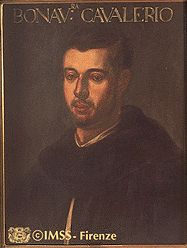
 |
| Bonaventura Cavalieri |
Bonaventura Cavalieri
(1598?-1647)
Born Francesco Cavalieri, in Milan, Cavalieri took the name Bonaventura when he entered the Jesuati (not Jesuit) order. He received minor orders in 1615 and was transferred to Pisa the following year. Here he studied philosophy and theology and came in contact with Benedetto Castelli, who introduced him to the study of geometry. To this study the brilliant Cavalieri devoted the rest of his life. In the four years he spent in Pisa, Cavalieri became an accomplished mathematician and a loyal disciple of Galileo.
In 1620 Cavalieri was recalled to Milan, where he became a deacon to (and protégé of) Cardinal Federigo Borromeo. He lectured on theology for three years in Milan and then became prior of St. Peter in Lodi and, in 1626, prior of the monastery of the Jesuati in Parma. In 1629, with the help of Galileo, he secured the chair of mathematics at the university of Bologna vacated by the death of the astronomer Giovanni Antonio Magini. Cavalieri remained in this position until his death in 1647.
Cavalieri published eleven books on mathematical subjects (including burning mirrors, astrology, and logarithms). He is chiefly remembered for his work on the problem "indivisibles." Building on the work of Archimedes, he investigated the method of construction by which areas and volumes of curved figures could be found. Cavalieri regarded an area as made up of an indefinite number of equidistant parallel line segments and a volume of an indefinite number of parallel plane areas. He called these elements the indivisibles of area and volume. Cavalieri's work was an important step toward the calculus, developed later in the seventeenth century by others, chiefly Isaac Newton and Gottfried Wilhelm Leibniz.
Sources: For details on Cavalieri's life and a brief introduction to his work, see Ettore Carruccio, "Cavalieri, Bonaventura," Dictionary of Scientific Biography III:149-153. For studies of Cavalieri's scientific researches, see Kirsti Andersen, "Cavalieri's Method of Indivisibles," Archive for History of Exact Sciences 31(1985):291-367; Piero E. Ariotti, "Bonaventura Cavalieri, Marin Mersenne, and the Reflecting Telescope," Isis 66(1975):303-321; Carl B. Boyer, "Cavalieri, Limits and Discarded Infinitesimals," Scripta Mathematica 8(1941):79-91.
Last updated
Science | Christianity | Library | About | Site Map | Search
Please note: We will not answer copyright requests.
See the copyright page for more
information.










